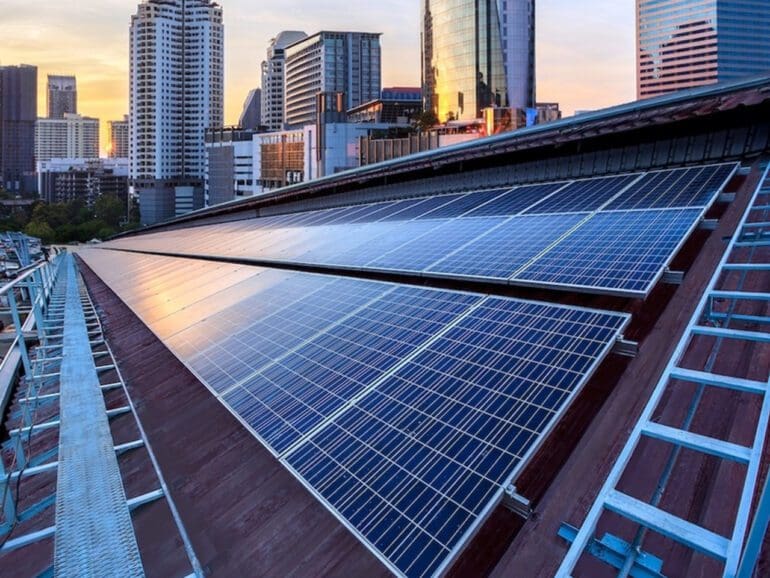The following is a guest post by Josh Goldberg, CEO and Co-Founder of Sunstone Credit.
With increasingly high energy costs across the United States, it’s no surprise that businesses that own property are looking for ways to effectively save while reducing their carbon footprint.
Luckily, with the entire United States receiving abundant sunlight and the declining cost of deploying solar energy, businesses that choose to go solar are uniquely positioned to save money and achieve their clean energy goals.
Still, the historically difficult process of going solar means the massive potential of the commercial solar market remains largely untapped.
We’ve yet to scratch the surface – less than two percent of commercial rooftops in the United States have solar because businesses fear that the significant upfront costs and perceived complex process of going solar outweigh the long-term savings.
And that doesn’t even consider other places for solar, like parking lots and undeveloped land.
Solar power is the best financial choice for business owners interested in saving money and going green.
What’s more: recent regulatory changes and new financial products are revolutionizing the economic realities of going solar while making it substantially easier for business owners to take the plunge. Here, I’ll explain how easy it is for business owners to fund – and immediately benefit from – solar energy.
Tax incentives can help boost your bottom line for years
The 2022 Inflation Reduction Act (“IRA”) isn’t just U.S. history’s most significant climate legislation. For businesses interested in going solar, it’s paved the way for substantial new incentives that dramatically offset the upfront costs and increase the lifetime return.
Of course, before any financial transaction, consult with your legal and tax professionals to evaluate the applicability of these incentives to your specific business. But for companies interested in going solar, below are some key incentives to consider.
The most exciting provisions of the IRA relate to the Investment Tax Credit (“ITC”). Available for installing systems through 2032, the ITC is a tax credit (today generally equal to 30% of the cost of the system) offered to offset the costs of installing businesses that go solar.
The IRA also provides another 10% in addition to the ITC – up to 70% total – if, among other things, your solar system achieves one of the following:
- Contains a certain amount of American-made components.
- It is located in a lower-income energy community.
- Provides power to lower-income off-takers.
- It is located near an abandoned mining operation.
And suppose your business isn’t tax efficient, or you aren’t a taxpaying entity. In that case, the IRA has provisions that allow you to sell your tax credit – or, for some nonprofits, receive a cash grant from the U.S. Treasury in lieu of a tax credit.
In addition to the ITC, solar is also eligible for bonus depreciation. Depending on the marginal tax rate of the business, this depreciation can help offset another 20 to 30% of the cost of a solar system. In many cases, state and local governments often offer additional incentive programs, too. So, depending on where your property is located, the regulatory incentives may be even more of a boon.
For business owners grappling with increasing electricity prices, these new and enhanced tax incentives are game changers and significantly improve the long-term economics of adopting solar. But while the regulatory changes driving the long-term value of going solar are great, new financial innovations are also driving solar adoption.
Next, let’s look at how the lending landscape has changed to eliminate the biggest barrier to a business going solar.

New solar lending options can help you be cash flow positive
There are no two ways about it: installing solar panels has a large upfront capital cost. And though tax credits, other incentives, and the power generated from the system create savings and strong economic returns over time, they don’t offer immediate relief for the upfront capital cost to purchase and install the system. As the saying goes, you have to have money to make money.
So to go solar, most businesses historically have been left with one of two terrible alternatives: either purchase solar using cash or go to a traditional lender who is likely to offer them a short-term loan or equipment lease poorly fit for the large upfront costs and predictable long-term cash flows of going solar.
Related:
Most equipment leases, for example, have a five to seven-year term. But solar panels have a useful life of over 30 years and offer predictable cash flow savings throughout their lifespan.
Traditional, shorter-term financial products often mean the purchaser is upside down for a long period of time before achieving substantial utility savings once the loan is paid off. While this tradeoff may seem to make sense in an Excel spreadsheet, the realities are tough to swallow. That is: “pay more now, save more later” just doesn’t work for a business in this economic environment.
Financing your solar system over a longer term of 10, 15, or 20 years, however, can help secure fixed monthly payments that are often lower than the monthly savings generated by the solar system. The longer-term fixed-rate financing helps make your monthly cash flow net positive. It’s a proposition that appeals to many businesses, especially in today’s economic environment.
Going solar offers financial benefits no matter where you live
Despite the common belief among many business owners that going solar may not be worth it in their area, the truth is that the benefits of solar power can be enjoyed in more places than one might expect.
For instance, while energy may be cheap in certain areas, such as the southeast, sunlight is also abundant in these regions, just like in California. And in areas like New York, where sunlight may be scarce, energy tends to be particularly expensive.
As a practical matter, it’s often viable for a business in all 50 states and DC to explore going solar with the right financing.
Going solar helps you gain greater control over your month-to-month and long-term energy expenses while boosting revenue. This makes the technology a unique opportunity for business owners searching for greater stability and increased cash flow in consistently turbulent economic waters.
So go solar, save money, and save the planet.


